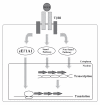Translational connection of TGFβ signaling: Phosphorylation of eEF1A1 by TβR-I inhibits protein synthesis
- PMID: 21776411
- PMCID: PMC3136913
- DOI: 10.4161/sgtp.2.2.15603
Translational connection of TGFβ signaling: Phosphorylation of eEF1A1 by TβR-I inhibits protein synthesis
Abstract
Transforming growth factor-β (TGFβ) signaling pathways regulate a wide array of cellular activities that are crucial for cell proliferation, apoptosis, migration and differentiation. TGFβ signaling pathways are initiated by ligand-activated TGFβ receptors, with type I TGFβ receptors (TβR-I) kinase being essential for phosphorylation of downstream targets. Until now, a prevalent view was that the TGFβ intracellular signaling targets would regulate transcription. Recently, we uncovered a novel TGFβ signaling pathway that exerts a direct regulatory effect on mRNA translation and protein synthesis. Eukaryotic elongation factor eEF1A1 is a GTP-binding protein that plays a central role in protein synthesis. By using a screening method for kinase substrate that was developed in our laboratory, we identified eEF1A1 as a novel substrate of TβR-I. This shed a new light on the convergence of TGFβ signaling and protein synthesis. We also showed phosphorylation of eEF1A1 at Ser300 by TβR-I prevents aa-tRNA binding to eEF1A1. As a consequence, TGFβ-dependent phosphorylation of eEF1A1 has an inhibitory effect on protein synthesis and cell proliferation. Therefore, we unveiled a novel regulatory mechanism of cellular proliferation by TGFβ at the translational level. Here we discuss this finding in the context of its potential role in the multiplicity of TGFβ signaling, and in the regulation of fundamental cellular functions, such as proliferation.
Figures


Similar articles
-
Inhibition of transforming growth factor-beta signaling by low molecular weight compounds interfering with ATP- or substrate-binding sites of the TGF beta type I receptor kinase.Biochemistry. 2002 Sep 10;41(36):11000-7. doi: 10.1021/bi025936u. Biochemistry. 2002. PMID: 12206672
-
Phosphorylation of eEF1A1 at Ser300 by TβR-I results in inhibition of mRNA translation.Curr Biol. 2010 Sep 28;20(18):1615-25. doi: 10.1016/j.cub.2010.08.017. Epub 2010 Sep 9. Curr Biol. 2010. PMID: 20832312
-
A novel protein distinguishes between quiescent and activated forms of the type I transforming growth factor beta receptor.J Biol Chem. 1998 Apr 17;273(16):9365-8. doi: 10.1074/jbc.273.16.9365. J Biol Chem. 1998. PMID: 9545258
-
The role of TGFbeta in human cancers.Pathology. 2001 Feb;33(1):85-92. Pathology. 2001. PMID: 11280615 Review.
-
Specification of BMP Signaling.Cells. 2019 Dec 5;8(12):1579. doi: 10.3390/cells8121579. Cells. 2019. PMID: 31817503 Free PMC article. Review.
Cited by
-
On the Need to Tell Apart Fraternal Twins eEF1A1 and eEF1A2, and Their Respective Outfits.Int J Mol Sci. 2021 Jun 28;22(13):6973. doi: 10.3390/ijms22136973. Int J Mol Sci. 2021. PMID: 34203525 Free PMC article. Review.
-
Highly homologous eEF1A1 and eEF1A2 exhibit differential post-translational modification with significant enrichment around localised sites of sequence variation.Biol Direct. 2013 Nov 13;8:29. doi: 10.1186/1745-6150-8-29. Biol Direct. 2013. PMID: 24220286 Free PMC article.
References
-
- Knudsen SM, Frydenberg J, Clark BF, Leffers H. Tissue-dependent variation in the expression of elongation factor-1 alpha isoforms: isolation and characterisation of a cDNA encoding a novel variant of human elongation-factor 1alpha. Eur J Biochem. 1993;215:549–554. doi: 10.1111/j.1432-1033.1993.tb18064.x. - DOI - PubMed
-
- Lee S, Francoeur AM, Liu S, Wang E. Tissue-specific expression in mammalian brain, heart and muscle of S1, a member of the elongation factor-1alpha gene family. J Biol Chem. 1992;267:24064–24068. - PubMed
-
- Kato MV, Sato H, Nagayoshi M, Ikawa Y. Upregulation of the elongation factor-1alpha gene by p53 in association with death of an erythroleukemic cell line. Blood. 1997;90:1373–1378. - PubMed
LinkOut - more resources
Full Text Sources
Molecular Biology Databases
Research Materials
Miscellaneous
